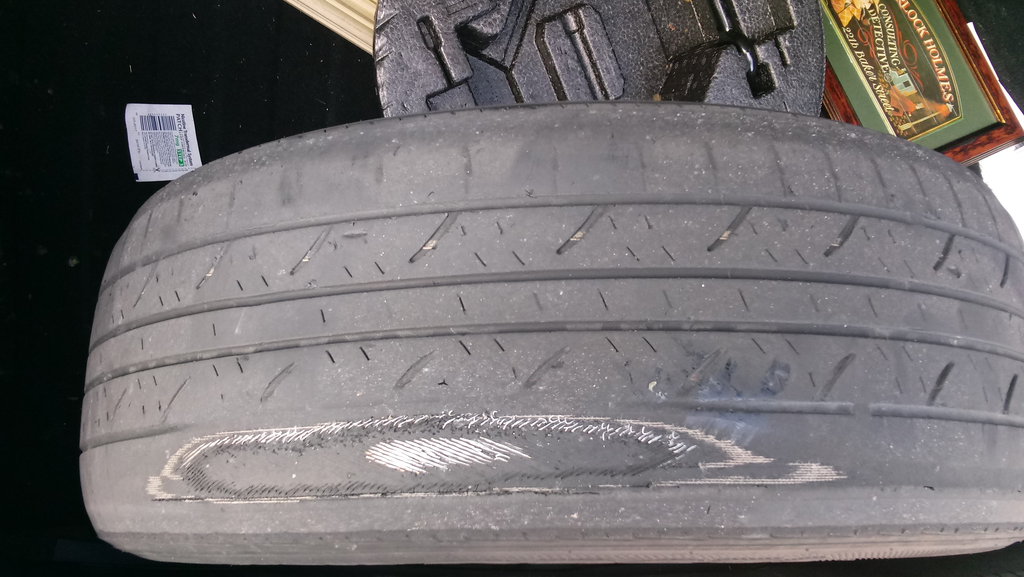Front tyres tend to wear out more quickly for a number of reasons: The front wheels are usually the ‘driving wheels’ and therefore undergo more traction, steering, cornering & braking forces.

- Do front & rear tires wear more?
- Under normal driving circumstances with a front-wheel drive vehicle (passenger cars, minivans, etc.), the front tires will wear at a slightly higher rate than the rear tires.
- Why do front tyres wear out more quickly?
- Front tyres tend to wear out more quickly for a number of reasons: The front wheels are usually the ‘driving wheels’ and therefore undergo more traction, steering, cornering & braking forces extra weight of the engine and transmission components are the front of the vehicle will cause front tyres to wear more quickly.
- Can you ride without a rear tyre?
- For illustration purposes only: It’s possible to ride without any rear tyre at all: youtu.be/acAlAd15pZA — Do this without a front tire and instantly crash; you need the most traction up front. The Good or less worn tire should go on the front wheel as indicated in this Sheldon Brown Article on Tire Rotation
- Do front wheel drive cars wear faster?
- Front wheel drive cars and trucks tend to wear the front tires faster. Rear wheel drive vehicles tend to wear the rear tires faster. Tire professionals, myself included, recommend replacing tires in pairs if not replacing all the tires. Many people will assume that the new pair of tires should be mounted on the front axle.
What causes uneven tyre wear?
Uneven tire wear is usually caused by improper alignment, overinflation, underinflation or a worn out suspension. It can be helpful to know the different uneven tire wear patterns below and what they may suggest about your car.
- What causes uneven tire wear?
- Tires serve as part of the suspension and are critical to be in good shape for your safety. Uneven tire wear causes are due to wear and tear on suspension parts or failing to check your tire pressure regularly. Staying on top of regular tire maintenance is important to preventing these problems and spotting underlying causes early.
- Why are my tyres wearing out more?
- Here, the inside or outside shoulder rib of the tread is significantly more worn than the others, similar to “ feathered” tyre wear. If your tyres are wearing away more in the middle, it’s likely due to over-inflation. With too much air in your tyres, the tread will bulge in the centre causing excessive tread wear.
- What is wrong with my tire alignment?
- A bad alignment adjustment may result in many different patterns of irregular tire wear. Under-inflated or over-inflated tires can cause irregular tire wear across the width of the tire tread. If your tire shows more wear in the center of the tread than at the two sides, it has been over inflated.
- How can I prevent uneven tread wear on my tires?
- The key to preventing uneven tread wear on your tires is regular maintenance of your car. Have a wheel balance and alignment check at least once a month. Wheel alignment is crucial because manufacturers design the suspension so that tires operate well for stable handling and tread wear.
Why do front tyres wear more?
1) The front wheels perform the steering of the vehicle and therefore move much more than the rear tyres, every time you turn the steering wheel the front tyres will generate more friction as they rotate against the road. 2) The front wheels generally take more impacts than the rear tyres.
Is it OK to swap front and rear tyres?
Tyre rotation is the process of changing the position of the tyres on your vehicle, often done by swapping front and rear car tyres. Ideally, tyres should be rotated at intervals of 6000 miles for cars and around 4000 miles for 4×4 vehicles, unless the manufacturer states otherwise.

- Should you swap tyres?
- Swapping them over could worsen the ride quality and grip levels. If you still want to rotate them, it’ll be different depending on the type of tyre and whether the car is front, rear or all-wheel drive cars. For directional tyres, the front tyres swap with the rears, staying on the same side of the vehicle.
- How do I change the tyres?
- Replace them with the rear tyres but move these to the opposite side. The rear right will go to the front left, the rear left to the front right. Again, the front tyres swap with the rear.
- Should you replace tyres at the rear of your vehicle?
- Therefore, to increase the longevity of the front wheels and to remove them from being put under too much pressure, tyres situated at the rear of the vehicle should be replaced more frequently. Having new tyres at the rear of your vehicle isn’t just good for wet weather conditions. It applies to dry weather also.
- Should tires be on the same side of the car?
- I’ve been taught (at some point) that when switching tires, you should take care to keep each tire on the same side of the car throughout its life. So if a tire starts its life at rear left, then moving it to front left is okay, but moving it to the right side (either front or rear) is a bad thing.






